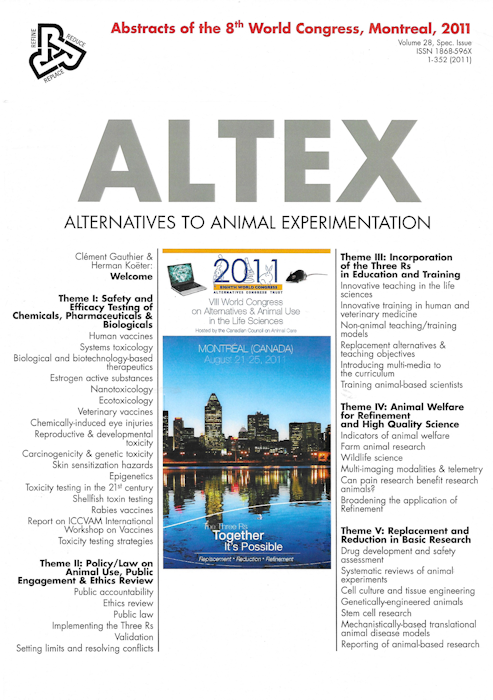
Welcome
Clément Gauthier and Herman Koëter
Editorial
Sonja von Aulock
Program overview
Plenary talks
Theme I
Safety and Efficacy Testing of Chemicals, Pharmaceuticals and Biologicals
I-1 Potency and safety testing of human vaccines
I-2 Addressing systems toxicology
I-3 Biological and biotechnology-based therapeutics
I-4 Regulatory testing paradigms and validation of alternative test methods for detecting estrogen active substances; impact on the Three Rs
I-5 Nanotoxicology and the Three Rs
I-6 Advances in alternative methods for ecotoxicology
I-7 Potency and safety testing of veterinary vaccines
I-8 Safety testing for chemically-induced eye injuries: Recent Three Rs advances
I-9 Advances in Three Rs alternatives for reproductive and developmental toxicity
I-10 Safety testing for carcinogenicity and genetic toxicity: Recent Three Rs advances
I-11 Safety testing for skin sensitization hazards: Recent Three Rs advances
I-12 Epigenetics and its increasing relevance in toxicology and risk assessment
I-13 Toxicity testing in the 21st century
I-15 Shellfish toxin testing: How are the Three Rs being progressed in this field?
I-16 Alternatives for potency testing of rabies vaccines
I-18 Report on the ICCVAM International Workshop on Vaccines
I-19 Toxicity testing strategies – progress in skin sensitization testing: A COLIPA supported session
Theme II
Policy/Law on Animal Use, Public Engagement and Ethics Review
II-1 Public accountability
II-2 Ethics review
II-3 Public law – the Three Rs in regulation addressing animal use
II-4 Implementing the Three Rs – alternatives to legislation
II-5 Validation of Three Rs alternative methods
II-6 Setting limits and resolving conflicts between the Rs
Theme III
Incorporation of the Three Rs in Education and Training
III-1 Innovative teaching in the life sciences
III-2 Innovative training in human and veterinary medicine
III-3 Development of non-animal teaching/training models
III-4 Replacement alternatives and teaching objectives – determining if and when student learning objectives require the use of animals
III-5 Introducing multi-media to the curriculum
III-6 Training animal-based scientists
Theme IV
Animal Welfare for Refinement and High Quality Science
IV-1 Indicators of animal welfare to implement refinement
IV-2 Farm animal research and the Three Rs
IV-3 Wildlife science and the Three Rs
IV-4 Multi-imaging modalities, telemetry and the Three Rs
IV-5 Can pain research benefit research animals?
IV-6 Broadening the application of Refinement
Theme V
Replacement and Reduction in Basic Research
V-1 Novel methodologies and their potential in vitro application for drug development and safety assessment
V-2 Systematic reviews of animal experiments
V-3 Cell culture and tissue engineering
V-4 Replacement and Reduction in the use of genetically-engineered animals
V-5 Developments in stem cell research as the basis for sustainable availability
of differentiated human cells and tissues
V-6 Animal reduction through the better use of mechanistically-based translational animal disease models
V-9 Improving reporting of animal-based research
Author Index
Imprint
Acknowledgment of Sponsors
Invitation to WC9

